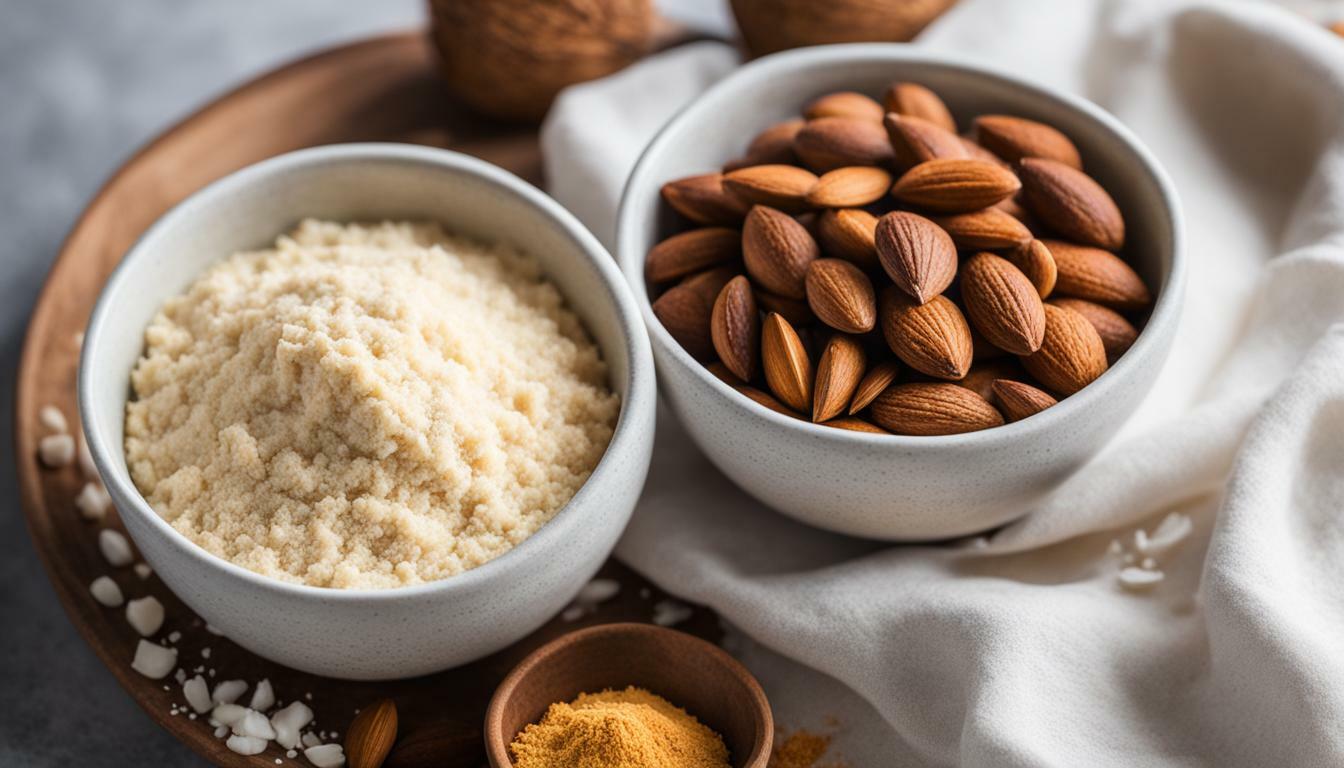When it comes to alternative flours, almond flour and coconut flour are two popular options. While they both offer unique benefits, they also have their differences. Understanding these distinctions can help you make informed choices in the kitchen. Let’s explore the key differences between almond flour and coconut flour.
Key Takeaways:
- Almond flour and coconut flour are two popular alternatives to wheat flour.
- Understanding the nutritional differences between almond flour and coconut flour can help determine the best option for your dietary needs.
- Almond flour and coconut flour have different culinary uses and can be substituted for traditional wheat flour in various recipes.
- The texture and flavor of baked goods can be affected by the use of either almond flour or coconut flour.
- Individuals with allergies or dietary restrictions should be aware of common allergens and suitable alternatives.
Nutritional Differences between Almond Flour and Coconut Flour
Almond flour and coconut flour are both popular alternatives to wheat flour and are often used in gluten-free and grain-free diets. But how do their nutritional profiles compare?
Macronutrients: Almond flour is higher in fat and protein than coconut flour. One cup of almond flour contains about 54 grams of fat, 20 grams of protein, and 12 grams of carbohydrates, while one cup of coconut flour contains 10 grams of fat, 20 grams of protein, and 58 grams of carbohydrates.
Vitamins and Minerals: Almond flour is a good source of vitamin E, magnesium, and phosphorus, while coconut flour is high in iron and manganese. Both flours are low in sodium and contain small amounts of calcium and potassium.
Health Benefits: Almond flour has been linked to improved heart health due to its high monounsaturated fat content, while coconut flour has been shown to help regulate blood sugar levels and improve gut health due to its high fiber content.
In summary, while both flours can be part of a healthy diet, they differ significantly in their nutritional content. Those seeking a high protein and fat option may prefer almond flour, while those looking for a high-fiber option may opt for coconut flour.
Culinary Uses of Almond Flour and Coconut Flour
Almond flour and coconut flour are versatile ingredients in the kitchen, offering a variety of uses in cooking and baking. They are particularly popular among individuals following gluten-free or low-carb diets.
Baking with Almond Flour and Coconut Flour
Both almond and coconut flour can be used in making cakes, cookies, muffins, bread, and other baked goods. Almond flour is known for producing rich and moist baked products, while coconut flour is light and airy. When using almond flour for baking, it’s best to combine it with eggs or other binding agents to help the batter hold together. Coconut flour, on the other hand, requires more liquid and eggs because it absorbs moisture well.
Cooking with Almond Flour and Coconut Flour
Aside from baking, both flours can also be used in cooking savory dishes, such as fried chicken, meatballs, and vegetables. Almond flour can be used as a coating for fried food, while coconut flour can be used as a thickener for soups and sauces.
Substituting Almond Flour and Coconut Flour for Traditional Flours
Almond and coconut flour can both be used as a substitute for wheat flour, making them a popular choice for those with gluten sensitivities. When substituting for wheat flour, it’s important to note that almond and coconut flour have different textures and absorb moisture differently. As a general rule, you can substitute 1 cup of wheat flour with 1/4 to 1/3 cup of almond flour or 1/3 to 1/2 cup of coconut flour. However, it’s recommended to follow recipes specifically designed for these flours to achieve the best results.
Texture and Flavor Comparison of Almond Flour and Coconut Flour
Aside from nutritional differences, almond flour and coconut flour differ in texture and flavor. These factors are essential to consider when deciding which flour to use in your recipe.
Texture
Almond flour has a finer texture compared to coconut flour. It creates a denser and moister texture, making it perfect for baking goods like pancakes, cookies, and cakes. Coconut flour, on the other hand, has a coarser texture and absorbs more liquid, resulting in a drier and crumbly texture. It is ideal for creating a crispy coating for fried foods and pie crusts.
Flavor
Almond flour has a nutty and slightly sweet flavor, similar to that of almonds. It blends well with other flavors, making it a versatile ingredient in various recipes. Coconut flour has a distinct coconut flavor, which can be overpowering in some recipes. It is best used in recipes that complement or enhance its coconut flavor, like coconut macaroons and coconut cakes.
In summary, both almond flour and coconut flour offer unique textures and flavors. Consider the texture and flavor you want to achieve in your recipe when deciding between the two.
Baking Tips and Recipes with Almond Flour and Coconut Flour
If you’re new to baking with almond flour and coconut flour, it can be intimidating. But fear not, here are some expert tips to get you started:
- When substituting wheat flour for almond or coconut flour, use a 1:2 or 1:3 ratio, respectively. This is because almond and coconut flours are more absorbent than wheat flour.
- Use eggs as binding agents, as both almond and coconut flours lack gluten, which gives wheat flour its elasticity.
- Mix almond flour with other gluten-free flours, such as rice or tapioca flour, for a lighter texture.
- When using coconut flour, increase the number of eggs in the recipe to ensure the batter doesn’t dry out.
- To enhance the flavor of almond flour, toast it in the oven for a few minutes before baking.
Now that you’re familiar with some tips, let’s move on to some delicious recipes to try:
1. Almond Flour Chocolate Chip Cookies
These cookies are gluten-free, dairy-free, and low in carbs. They’re perfect for those with a sweet tooth who want a healthier alternative to traditional cookies.
| Ingredients: | Instructions: |
|---|---|
|
|
2. Coconut Flour Banana Bread
This bread is moist, fluffy, and full of banana flavor. It’s also gluten-free, dairy-free, and low in carbs.
| Ingredients: | Instructions: |
|---|---|
|
|
These are just two examples of the many delicious recipes you can make with almond flour and coconut flour. Don’t be afraid to get creative and experiment with different flavors and ingredients!
Considerations for Allergies and Dietary Restrictions
While both almond flour and coconut flour are great alternatives to wheat flour, they may not be suitable for everyone, especially those with allergies or dietary restrictions. Here are some factors to consider:
- Differences between almond flour and coconut flour: Almond flour is made from almonds, which are tree nuts. Those with nut allergies should avoid almond flour. On the other hand, coconut flour is made from coconut, which is a fruit. It is generally safe for those with nut allergies, but those with coconut allergies should avoid it.
- Health benefits of almond flour and coconut flour: Both almond flour and coconut flour have great nutritional value. Almond flour is high in protein, healthy fats, and vitamin E, which is an antioxidant that protects cells from damage. It is also low in carbs and is suitable for those on a low-carb diet. Coconut flour is high in fiber, which promotes good digestion and helps regulate blood sugar levels. It is also gluten-free and suitable for those on a gluten-free diet.
If you have allergies or dietary restrictions, there are alternative flours that you can use instead. For nut-free options, consider using cassava flour, sunflower seed flour, or pumpkin seed flour. For coconut-free options, try using tapioca flour, arrowroot flour, or rice flour. Always check the labels and ingredients to make sure the flour is safe for your specific needs.
Conclusion
In conclusion, almond flour and coconut flour are two popular alternatives to traditional wheat flour that offer unique nutritional benefits and culinary uses. While both flours are low in carbohydrates and rich in healthy fats, they differ significantly in terms of taste, texture, and application.
Almond flour is a versatile flour that provides a slightly nutty flavor and dense texture, making it a great choice for baking bread, cookies, and cakes. On the other hand, coconut flour is a light and fluffy flour with a subtle coconut flavor, making it an ideal choice for pancakes, muffins, and other delicate baked goods.
When considering the differences between almond flour and coconut flour, it is important to take into account individual dietary needs and preferences. Those with nut allergies should opt for coconut flour, while those with a sensitivity to coconut should choose almond flour instead.
In summary, both almond flour and coconut flour have their place in the kitchen and can be used interchangeably in many recipes. By experimenting with these flours, you can unlock a whole new world of culinary possibilities, all while enjoying their numerous health benefits.
So whether you’re a gluten-free enthusiast, a paleo devotee, or simply looking to try something new, almond flour vs coconut flour – the differences between almond flour and coconut flour is a choice worth exploring.
 Skip to main content
Skip to main content


